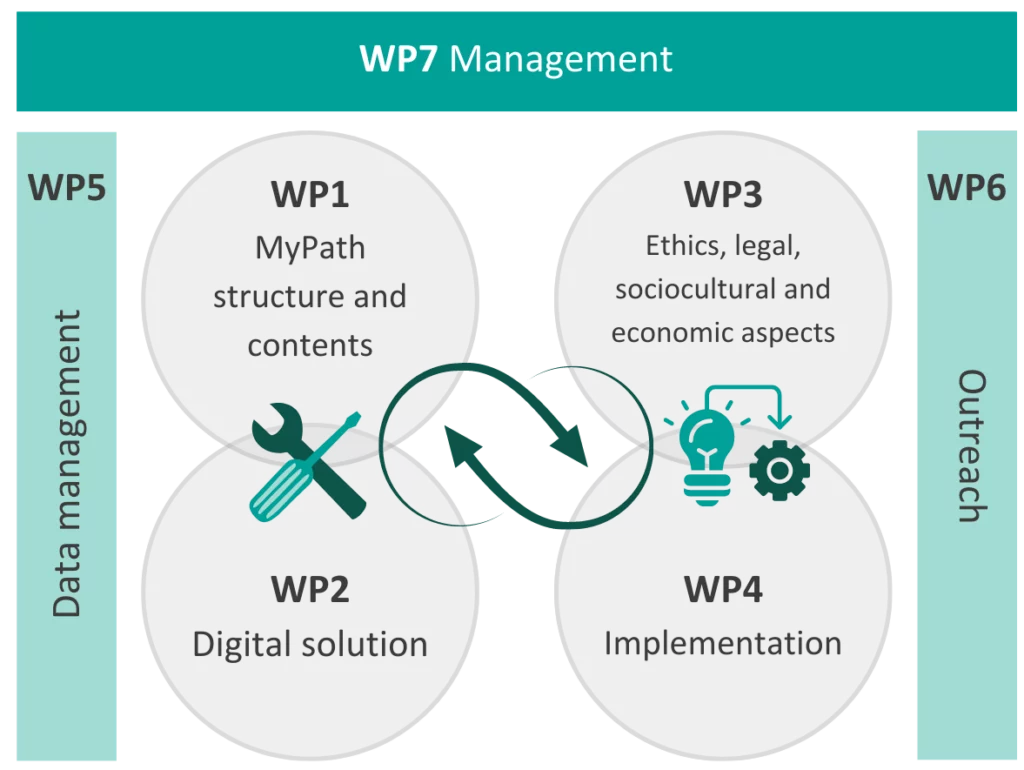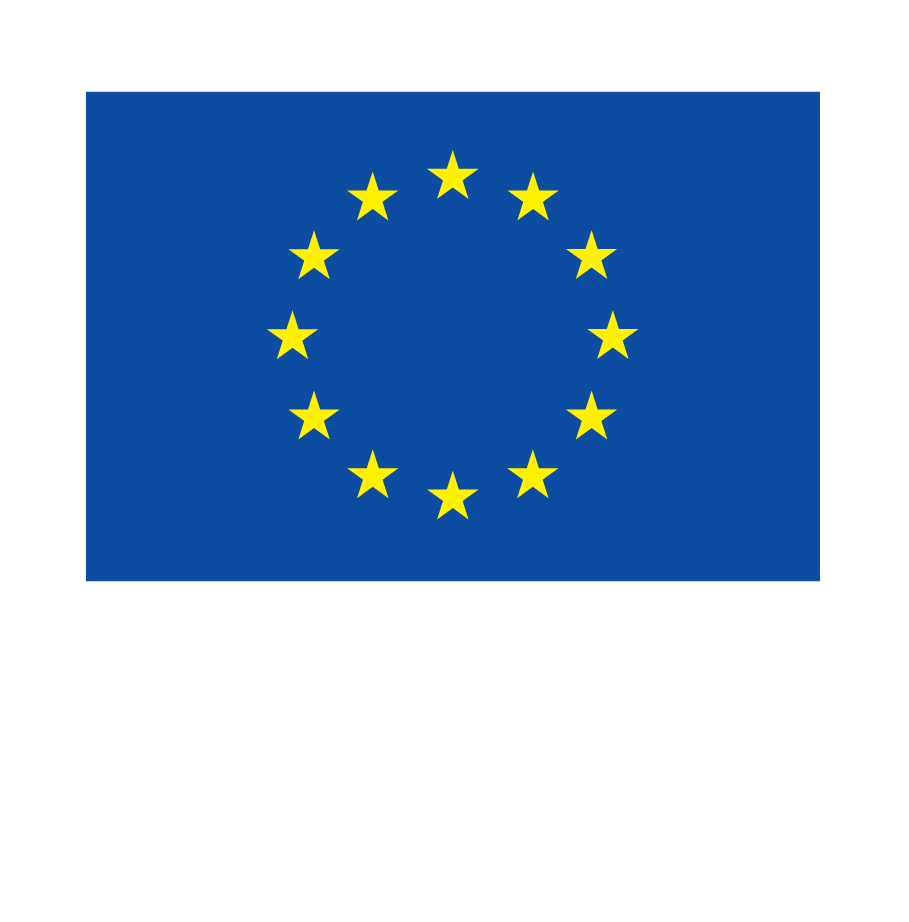The project consists of seven closely aligned and fully integrated work packages. Among these, WP1-5 are scientific work packages, WP6 is dedicated to communication, dissemination, and outreach activities, and WP7 is responsible for the overall project coordination.

Lead: University of Leeds
The main goal of WP1 is to develop and deliver the evidence-based content and structure for improved, individual patient-centred cancer treatment and care in Europe, to be configured in the electronic pathway, i.e. MyPath (WP2). More explicitly we will:
- Develop the clinical and patient-centred content for MyPath
- Evaluate existing (e)PROMs and (e)PREMs, revise current version of Eir, refine and add clinical algorithms to optimise Eir-content and responses to PROMs/PREMs for MyPath
- Define patient categories incl. subtypes and groups, i.e. cancer diagnosis, stage and group; i.e. curative treatment, survivorship, life-prolonging treatment, palliative care, supportive care, end-of-life according to a decision-tree model to decide the patient-centred MyPath structure with individualised patient pathways
- Perform iterative test rounds and revisions of content and structure based on end-user testing with local, cultural, societal and religious adaptations at 4 centres
- Refine content of the final MyPath for wider European use and prepare for future commercialisation
The key innovations of WP1 will be:
- A digital solution that generates individual patient-centred care pathways (PCCPs) for use in supportive, palliative, survivorship and end-of-life cancer care for integration in European hospital and community cancer care
- A dynamic PCCP called MyPath with integrated use of PROMs and PREMs (patient’s voice) and clinical data through communication with electronic medical records (EMR)
- Provision of decision support for the five key, yet insufficiently managed areas: pain, nutrition, physical function, social function and psychological distress
Lead: DNV Imatis
The main goal of WP2 is to develop the MyPath prototype; the digital patient-centred care pathway with PROMs and PREMs, computer-based decision support and communication with the electronic medical records (EMR).
More specifically we will:
- Set up the Imatis Fundamentum platform for integration of MyPath for accessibility by patients on any digital device via WiFi, and for health care providers from within the hospital firewall or in the cloud, contingent on local and national regulations in collaboration with local ICT departments
- Configure the architecture of the pathway using Imatis’ Low-Code Toolbox and its patient-centred content according to collected data and input from WP1, and WP3, iterative test rounds
- Configure the PROMs and PREMs and computer-based decision support in the platform or create necessary applications from within the Imatis’ eco-system or new apps built with the Imatis’ Low-Code Application Platform as needed
- Multiple test rounds of first and subsequent pilot versions, incl. scoping of local ICT requirements in a pilot study
- Configure communication between MyPath and the electronic medical record (EMR), and communication between patients and healthcare providers on any digital device via WiFi and healthcare providers using available apps from the Imatis’ eco-system
- Iterative adaptations of the first MyPath prototype in the implementation study (WP4), along with WP3-4
- Develop the final MyPath prototype
The key innovations of WP2 will be:
- A digitalised pathway for use in patient-centred treatment and care of cancer patients irrespective of age, disease stage and treatment intent (curative, palliative, life-prolonging, end-of-life)
- An easily accessible ICT solution that provides patient-centred care pathways with individualised care based on patients’ PROMs and PREMs and clinical data
- MyPath is configured with applications that provide computer-based decision support according to algorithms built on evidence treatment guidelines
Lead: Vrije Universiteit Brussel
Supportive, palliative, end-of-life and survivorship care are organised in substantially different ways across countries and even across hospitals. Investigating the structures, cultures, ethics and health economics related to the implementation of MyPath will generate information on the different contexts in which MyPath will be integrated. Integrating MyPath into cancer care involves bringing together administrative, financial, organisational, educational, clinical and service aspects in order to realize the continuity of cancer care between all actors involved in the care of the cancer patients. It aims to achieve quality of life and well-supported care processes for the patients and their families in collaboration with all the professional caregivers. Therefore, implementing the MyPath care pathway will imply organisational (structure) and cultural (knowledge, skills and attitudes) transitions for all actors involved in the care of the cancer patients in all participating centres.
The main goal of WP3 is to prepare the structural, social, ethical and cultural transitions in the cancer centres, and demonstrate the economic, societal and health-related values of implementing the MyPath in cancer care. Furthermore, it includes the development of a health economic model, which incorporates costs and outcomes, projected over a pertinent time-horizon.
The key innovations of WP3 will be:
- Identification of preconditions for a successful implementation of an electronic patient-centred care pathway
- Development of the transition components to integrate MyPath into cancer care: policy guidelines, education, digital literacy of stakeholders, and tools to apply for the implementation of the MyPath, solving cultural, societal, organisational barriers
- Production of an underpinning health economic model to estimate the country-specific and institution-specific cost-consequence and budget impact of implementation scenarios
Lead: University of Edinburgh
The main goal of WP4 is to conduct the implementation of MyPath in each of nine European Cancer Centres using the implementation science methodology. More explicitly we will:
- Through close collaboration with WPs 1, 2, and 3, communicate and prepare each cancer centre for MyPath implementation study
- Iteratively help to develop and optimise the MyPath intervention
- Appoint and train implementation study facilitators and collect baseline data
- Conduct a qualitative formative feasibility evaluation
- Conduct a qualitative process evaluation of the main MyPath intervention
- Final analyses of study
- Develop, review, and refine “Theories of Implementation” within trial sites and for wider use of MyPath in Europe/elsewhere
The key innovations of WP4 will be:
- First study of the implementation of a digital pathway in cancer care using implementation science approaches
- Evidence of digital pathway use and how it is used by patients and clinicians, in addition to evidence of facilitators and barriers through formal implementation science methodology
- European scope, with the involvement of nine clinical centres
- Implementation science as a step towards future deployment and adoption in clinical practice
Lead: Oslo University Hospital
The main goal of WP5 is to plan and conduct the handling and facilitation of the data collections in WP1, 2 and 4, transmittance and storage of all data collected with continuous quality assurance (QA) in collaboration with WP1 and WP7 and contribute to data analyses. Secure that all procedures are according to Good Clinical Practice (GCP), confidentiality, legal and ethical national and international regulations at all centres. More specifically, we will:
- Develop working procedures for the MyPath-CTU within the Clinical Trial Unit at OUS
- Create a web platform for efficient communication between the local and central MyPath-CTUs
- Establish small on-site management CTUs for local data collection, handling and storage in Phase 1 (WP1/WP2, 4 sites) and Phase 2 (WP4, 9 sites) with designated personnel and facilitators
- Define standard operating procedures (SOP) for the collection and storage of: a) qualitative data, defined as end-user input (interviews, focus groups) on the WP1 content; and user-friendliness issues (observational studies, think-aloud methods) in patients and health care providers; b) quantitative data, defined as usability outcomes on the functioning of ICT pathway, technically and perceptive layout, scoring, lag time, missing replies
- Train the local CTU-personnel and facilitators with interactive webinars and face-to-face meetings in collaboration with WP1 and WP4
- Define and develop the electronic specifications for data collection, storage and transfer
- Ensure that data management is GDPR compliant and aligned with the FAIR (Findable, Accessible, Interoperable and Reusable) principles in synergy with WP7
Lead: accelopment Schweiz AG
The main goal of WP6 is to raise awareness and disseminate results for the project as a whole and our two key innovations, the MyPath and the implementation study. More specifically, we will:
- Define and plan a dissemination and communication strategy to ensure the widest possible outreach of the project, the MyPath and Implementation tool kit in a multi-stakeholder Communication and Dissemination Plan (CDP)
- Deliver cross-media communication activities to raise awareness
- Disseminate the project results to the scientific community and complementary research initiatives
- Exploit the commercial and non-commercial opportunities of the MyPath solution, developments and outcomes to stakeholders interested in the further use and development of results
Lead: Oslo University Hospital
The main objectives of WP7 are to ensure scientific integrity and efficiency, along with efficient administration and effective project leadership and management. We will:
- Ensure the ongoing scientific integrity of the WPs, and effective leadership, governance and management among WP leaders throughout the project and facilitate interactive processes between WPs
- Provide management of administrative and technical tasks, including contracts
- Apply timely financial and scientific, technological and management reporting
- Define and apply quality processes, assess risks and implement mitigation measures
- Develop a suitable innovation process and manage the project results for future exploitation
- Manage data, intellectual property (IP) to promote innovation and ensure legal compliance


